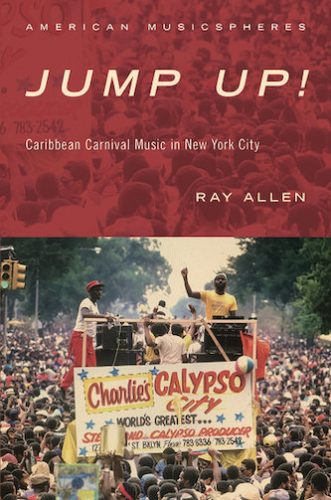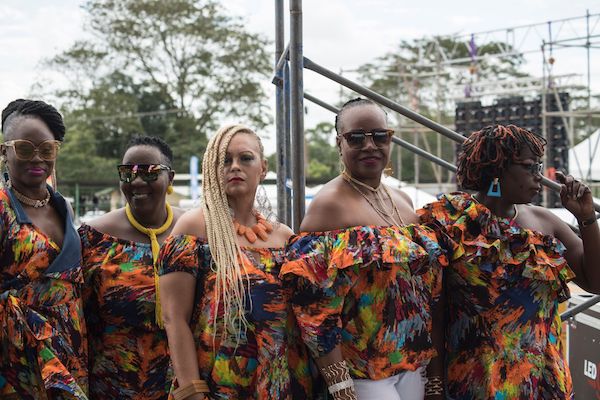Book Review: Two Glimpses of Caribbean Culture in a Year without Carnival
By Noah Schaffer
A pair of recent books help keep the glorious spirit of Carnival alive.

Normally at this time of year Boston would be enjoying its second burst of Caribbean music, dance, food, and especially costumes, thanks to the Cambridge Carnival. Revelers would be debating the highlights of the August Boston Carnival and the New York Labor Day West Indian Day Celebration while making plans for the South Florida Carnival events in October.
None of that is happening, of course, because of pandemic. (The Cambridge Carnival, canceled in 2019 due to alleged safety issues, will be airing a virtual edition.) Like all large gatherings, the status of the 2021 Carnival in Trinidad and Tobago — and if Americans will even be allowed to travel there — remains uncertain. But, for those of heavy heart, a pair of recent books help keep the glorious spirit of Carnival alive.
Jump Up! Caribbean Carnival Music in New York is the result of years of research by Brooklyn College, CUNY professor Ray Allen. (Click here to buy.) The volume explores how the Caribbean diaspora in New York didn’t just do its best to keep Caribbean culture alive, but played a pivotal role in the creation and distribution of such art forms as calypso and steel band.
Allen details how, after the mid-century Harlem Carnival was shut down, the famed Brooklyn Carnival sprung up as a series of street fetes organized by Rufus Gorin, who found himself arrested when the police cracked down on the parties. A judge suggested to Gorin that he form an organization and through it apply for a permit. A transit worker named Carlos Lezama applied his sharp bureaucratic and political skills to the formation of the West Indian American Carnival Association, which grew into a formidable nonprofit responsible for an event that draws tens if not hundreds of thousands of revelers each year.
The book also dives into the rise of steel band contests, examining how arrangers, by immigrating to America, helped propel the all-percussion orchestras that compete each year. Chapters on the calypso and soca scenes reveal how Brooklyn became an epicenter for those Caribbean genres, especially through the likes of Charlie’s Calypso City and Straker’s Records.
Though his book was released through an academic press, Allen tells a fascinating and largely unwritten history of diaspora culture in an accessible way. His conclusion sadly notes that gentrification and political pressure is threatening the survival of the Brooklyn Carnival. Allen ends on an optimistic note, proclaiming “Carnival was and continues to be deeply embedded in the Caribbean culture DNA.”
The roots of that DNA is explored in Boston photographer and cultural activist Michael C. Smith’s second photo book, Culture, People, Places: Trinidad and Tobago. (Click here to buy.) I interviewed Smith at this time last year for the Arts Fuse when he published a Boston Carnival book, Culture Lives Here. In his new publication, Smith documents his journey back to Trinidad and Tobago for the 2020 Carnival — the first time in over 30 years he had returned to the land of his birth.

A photo from Michael C. Smith’s Culture, People, Places: Trinidad and Tobago.
Although Smith has never been shy when it comes to expressing his hopes and dreams for Caribbean events, Culture, People, Places has only a brief, page-long introduction. What follows are 240 pages of beautifully reproduced color images that evoke the sounds and spirits of Carnival.
It is a rich parade of pictorials: breathtaking shots of calpysonians performing amid elaborately costumed revelers and steel bands. Ironically, some of the most book’s evocative photos are shots of everyday life during Carnival season: water taxi employees on a break, Carnival bands busily preparing to hit the road, and a backing orchestra rehearsing for a stage show. Smith was also wise to take the time to capture Trinidad and Tobago’s natural beauty as well as the gritty waterfront commerce that birthed the steel pan tradition.

A photo from Michael C. Smith’s Culture, People, Places — Trinidad and Tobago.
In truth, a few more words in this captionless book would have been welcome, especially when it comes to identifying the calypso entertainers on display. Still, Culture, People, Places shows that in early 2020 Trinidad and Tobago Carnival was very much alive, presenting its culture like nowhere else on earth. Given that there is so much uncertainty about the future of traditions in a time of COVID-19, it’s a reassuringly valuable document.
Over the past 15 years Noah Schaffer has written about otherwise unheralded musicians from the worlds of gospel, jazz, blues, Latin, African, reggae, Middle Eastern music, klezmer, polka, and far beyond. He has won over 10 awards from the New England Newspaper and Press Association.

Thank you sir – much appreciated